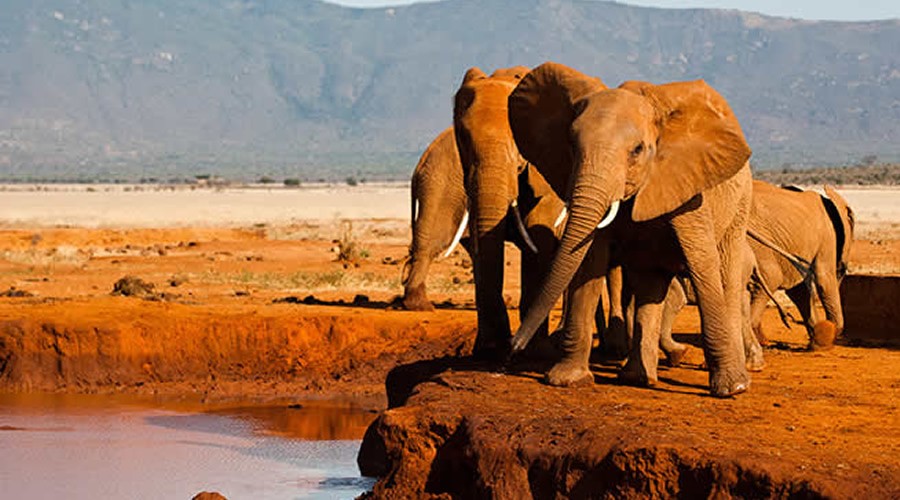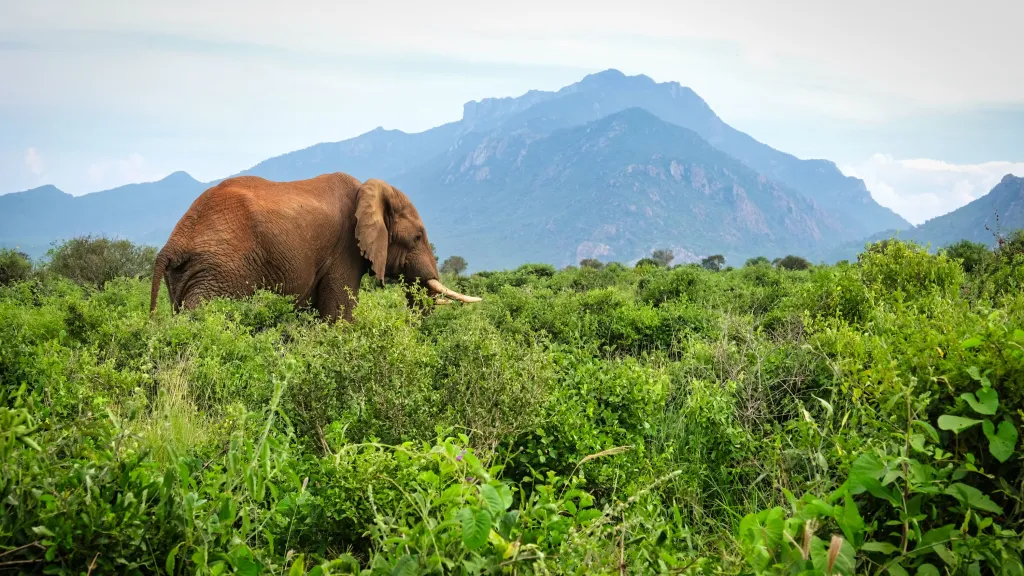Kenya is home to some of the world’s most spectacular wildlife parks where you can encounter the Big Five: lion, leopard, rhinoceros, elephant, and buffalo. This journey through Maasai Mara, Tsavo, and Amboseli National Parks reveals their uniqueness and the rich biodiversity that makes them top destinations for safari enthusiasts.
The Iconic Big Five of Kenya
The Iconic Big Five of Kenya:
The term “Big Five” was originally coined to denote the difficulty in hunting the lion, leopard, rhinoceros, elephant, and buffalo, and not necessarily their size. Today, these animals are among the most sought-after by tourists for their majesty and rarity. Their significance stretches beyond the thrill of spotting them in the wild to playing pivotal roles in the African ecosystem and contributing to the tourism industry, vital for many African economies.
Lions, known for their majestic mane and social prides, symbolize strength and courage. They are often found in the savannahs of the Maasai Mara National Reserve, engaging in the hunt or nurturing their young. Leopards, elusive and solitary, are mostly nocturnal. They are skilled climbers, often dragging their prey up trees to fend off scavengers, showcasing a remarkable adaptation for survival.
The rhinoceros, with its prehistoric appearance, comes in two varieties in Kenya: the black and the white rhino. Despite their names, color does not distinguish them; instead, their lips do. Rhinos are critically endangered, with poaching and habitat loss posing significant threats to their dwindling numbers.
Elephants, the largest land animals, are known for their intelligence, complex social structures, and impressive memories. Found in the vast landscapes of Amboseli National Park against the backdrop of Mount Kilimanjaro, they roam in herds, led by a matriarch, symbolizing family bonds and unity.
Buffaloes, perhaps the least glorified among the Big Five, are immensely powerful and unpredictable, making them dangerous and revered by hunters and locals alike. They thrive in large herds, grazing in the plains, or cooling off in muddy waters, a common sight in the expansive Tsavo National Park.
Conservation efforts across Kenya aim to protect these magnificent creatures from the threats of poaching and habitat loss. Anti-poaching units, community education, and wildlife corridors are among the measures undertaken to ensure their survival for future generations. The Big Five are not just essential for biodiversity but are also emblematic of Africa’s heritage, underscoring the urgent need for conservation.
Maasai Mara: A Haven for Wildlife
Following the exploration of the Iconic Big Five of Kenya, our journey transitions seamlessly into the breathtaking expanses of the Maasai Mara National Reserve, a sanctuary that not only plays host to an incredible diversity of wildlife but also serves as a backdrop to one of nature’s most awe-inspiring spectacles: the Great Migration. Nestled in the southwest of Kenya, Maasai Mara is an undulating plain, brushed with swaying grasslands, dotted with acacia trees, and sliced through by the Mara and Talek Rivers, creating a landscape of unparalleled scenic beauty and ecological importance.
The reserve’s geographical splendor is matched by its significance as a haven for wildlife, particularly for the Big Five. Here, lions roam with a lazy majesty, leopards prowl in solitary silence, elephants tread ancient pathways with ponderous grace, buffalos gather in imposing herds, and the elusive rhinoceros adds a prehistoric depth to the landscape’s diversity. These species, critical both ecologically and as flagship beings for conservation efforts, are more than just inhabitants of the Maasai Mara; they are symbols of Africa’s wild heart, drawing visitors from across the globe.
However, the Mara’s wild theater extends beyond the Big Five. It’s a stage for the Great Migration, a cyclical event where millions of wildebeest, zebra, and other hoofed animals traverse the Serengeti-Maasai Mara ecosystem in a quest for fresh grazing, closely shadowed by predators. This natural spectacle, often heralded as one of the Seven New Wonders of the World, epitomizes the raw and untouched nature of the African wilderness.
The Maasai Mara is also a cultural mosaic, named after the Maasai people-an ethnic group synonymous with this part of Kenya. Their presence adds an enriching layer to the reserve’s narrative, showcasing a life in coexistence with the wild. This symbiotic relationship offers a unique insight into the ways in which conservation efforts can harmonize with traditional ways of living, ensuring the preservation of this exceptional ecosystem for future generations.
The best times to visit the Maasai Mara are during the dry seasons, from July to October, for the Great Migration, and December to February, for excellent game viewing. During these periods, visitors are not only treated to the dramatic spectacle of the migration but also to the reserve’s abundant resident wildlife in a stunning, accessible setting.
Experiences in the Maasai Mara are varied and profound, from the thrilling drives in pursuit of the Big Five to the serene moments watching the sun dip below the horizon, painting the sky with hues of orange and red. Every turn unveils a new chapter of the wild narrative that is both ancient and ever-evolving. The ongoing story of the Maasai Mara is a testament to the natural beauty, the cultural heritage, and the conservation success that Kenya has to offer, making it an indispensable chapter in the exploration of Kenya’s majestic wildlife and scenic beauty.
As we leave the Maasai Mara, our adventure leads us to the vast landscapes of Tsavo National Park, where unique geological formations and a rich tapestry of biodiversity await. Here, the narrative of Kenya’s awe-inspiring natural world continues, woven into the rugged terrain and the ancient stories etched into the land.
Tsavo National Park: A Land of Adventure
Transitioning from the wildlife-rich plains of Maasai Mara National Reserve, our journey through Kenya’s majestic parks takes us to the vast landscapes of Tsavo National Park. This park is distinguished not only by its immense size, covering about 4% of Kenya’s total land area, but also by the sheer diversity of its habitats, ranging from the semi-arid grasslands and savannahs to the mountainous terrain overshadowed by the Yatta Plateau, the world’s longest lava flow. Such varied ecosystems host an abundance of wildlife, including the sought-after Big Five – lions, elephants, buffaloes, leopards, and rhinoceroses, albeit the latter can be more elusive in this expansive wilderness.
The park’s history is as rich as its biodiversity. Tsavo is home to significant archaeological sites that paint a picture of early man’s life millions of years ago. Moreover, the haunting tales of the Tsavo Man-Eaters, a pair of maneless male lions, have become legendary, adding a mystique to the park and highlighting the complex relationship between humans and wildlife over the ages.
Beyond the shadow of the past, Tsavo today is a sanctuary where the Big Five roam freely. The elephants of Tsavo, covered in the park’s distinctive red dust, provide some of the most iconic images of African wildlife. The lions, although elusive, rule their savannah kingdom with undisputed majesty. Bufaloes congregate in large herds around the water sources, while leopards, the most reclusive of the Big Five, grace the landscape with their silent, shadowy presence.
Conservation efforts in Tsavo are ongoing and critical. The park’s vastness presents unique challenges, from poaching to human-wildlife conflict. The dedicated teams on the ground, including rangers and scientists, work tirelessly to protect this irreplaceable ecosystem, ensuring it remains a beacon of natural beauty and wildlife diversity. Their efforts secure the future of Tsavo’s wildlife and preserve its status as a landmark of Kenyan heritage.
As our exploration moves on to the iconic Amboseli National Park, we carry with us the awe-inspiring experiences from Tsavo. Amboseli’s landscapes promise another unique chapter in our Kenyan safari adventure, with its famed elephant herds and the stunning backdrop of Mount Kilimanjaro.
Amboseli National Park: Elephants in the Mist
Unfortunately, you did not provide any article text for me to update. Please provide the text for the chapter on Amboseli National Park that you’d like to have the internal links added to, and I’d be happy to assist.
Sustainable Safari Tourism and Conservation
Sustainable Safari Tourism and Conservation: Addressing the importance of sustainable tourism practices is crucial for the preservation of Kenya’s wildlife parks. Respecting the delicate balance of ecosystems is vital in maintaining the natural habitats of the Big Five and other wildlife, ensuring their survival for generations to come. Through responsible tourism, visitors can help support conservation efforts, thereby benefiting local communities economically and socially.
Sustainable tourism emphasizes the need for minimal environmental impact and positive engagement with local communities. By choosing eco-friendly accommodations and respecting wildlife viewing protocols, tourists play a direct role in the preservation of natural resources and wildlife. This approach not only aids in reducing the carbon footprint but also in preventing habitat destruction and the disturbance of animal populations.
Community-based conservation projects stand as a testament to the success of collaborative efforts between conservation organizations, local communities, and the government. Such initiatives aim to provide alternative income sources to local communities, reducing dependence on natural resources and promoting wildlife conservation. By involving communities in tourism, there’s a stronger incentive to protect wildlife, which in turn secures their livelihood.
Kenya’s efforts in conservation have been bolstered by both national and international organizations dedicated to the protection of its natural heritage. These organizations work tirelessly to fund and implement conservation projects, anti-poaching measures, and educational programs that raise awareness about the importance of wildlife preservation.
Promoting sustainable safari tourism in Kenya’s renowned national parks, including Amboseli National Park, Masai Mara National Park, and Tsavo National Park, is imperative. Through responsible travel practices, awareness, and supportive conservation efforts, the majestic beauty and diverse wildlife of Kenya’s parks will continue to thrive for many years to come.
Conclusions
Kenya’s national parks, home to the Big Five, offer invaluable natural and cultural riches. From Maasai Mara’s majestic migrations to Amboseli’s elephants and Tsavo’s vast landscapes, these parks are crucial for conservation. Sustainable tourism must continue to play a key role in preserving these wonders, ensuring that future generations can experience Kenya’s unparalleled wildlife and scenic beauty.




